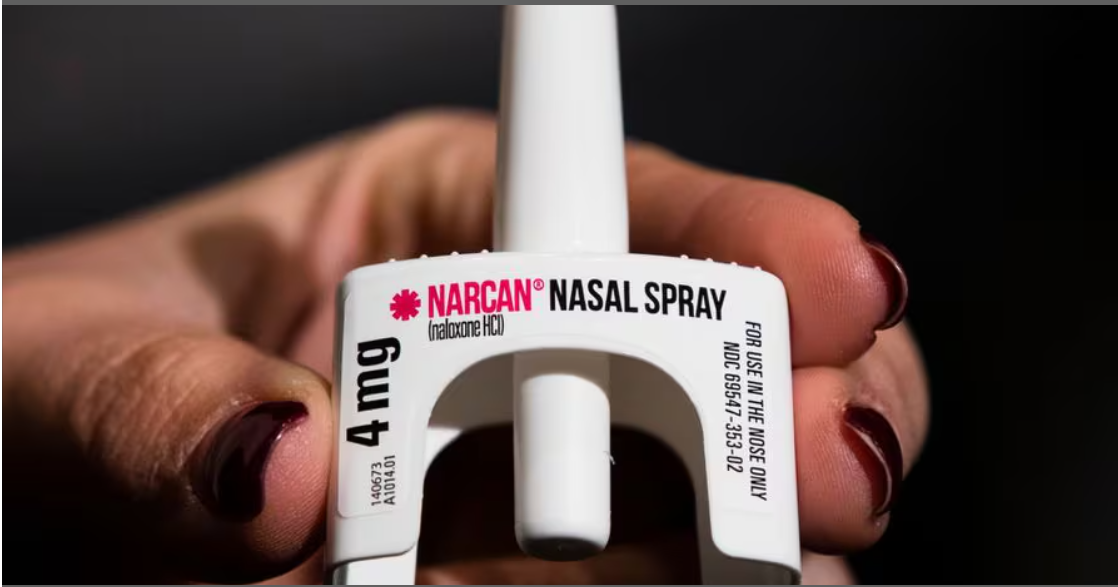马萨诸塞州阿片类药物相关死亡人数出现十多年来最大降幅

[中美创新时报2024 年 6 月 13 日编译讯】(记者温友平编译)根据最新发布的州数据,2023 年马萨诸塞州因阿片类药物过量而死亡的人数下降了 10%,这是该州十多年来的最大降幅。
《波士顿环球报》记者杰森·劳克林(Jason Laughlin)对此作了下述详细报道。
根据最新发布的州数据,2023 年马萨诸塞州因阿片类药物过量而死亡的人数下降了 10%,这是该州十多年来的最大降幅。
在死亡率创下两年新高之后,这一消息带来了一丝希望。
然而,根据周三公布数据的公共卫生部的数据,今年的死亡总人数为 2,125 人,仍是 2001 年以来的第三高。此外,该州最大城市波士顿所在的萨福克县报告的死亡人数比上一年增加了 8.6%,黑人居民的死亡率达到五年来的最高水平。

“我们还有很多工作要做,”该州药物成瘾服务局局长迪尔德丽·卡尔弗特(Deirdre Calvert )在周二的简报会上说。“我们真的需要关注我们缺失的社区和我们无法接触到的社区。”
处方药、海洛因以及最近的芬太尼导致了与阿片类药物相关的成瘾和死亡。州数据显示,大约十年前,随着芬太尼等合成阿片类药物变得越来越普遍,过量服用导致的死亡人数开始飙升。2022 年,创纪录的 2,357 人死于过量服用。
根据新数据,去年接受毒理学测试的过量服用受害者中 90% 的人体内含有芬太尼。 9% 的受试对象体内含有赛拉嗪,这是一种动物镇静剂,也被称为 tranq,高于 2022 年的 5%。
参与抗击阿片类药物危机的人士表示,自 2019 年以来,每年的死亡人数持续走高,而这种数字呈下降趋势是一个可喜的变化。早期迹象表明,今年的下降趋势可能会持续。DPH 估计,1 月至 3 月间因阿片类药物过量而死亡的人数比去年同期有所减少。
布罗克顿社区健康中心药物使用服务主任艾莉森·平克霍弗(Allyson Pinkhover )表示,看到州数据时,她心情复杂。她说,去年的死亡人数令人沮丧,但她不禁“松了一口气”,因为有一些改善的迹象。
“你绝对必须接受你在这方面取得的小胜利,”平克霍弗说,“否则我认为这项工作会让你筋疲力尽。”
该州 14 个县中有 7 个报告阿片类药物过量相关死亡人数下降,而杜克斯县 2023 年的死亡人数与前一年相同(6 人)。在报告死亡人数增加的六个县中,萨福克县死亡人数最多,2023 年报告死亡人数增加 26 人。
根据美国疾病控制和预防中心的数据,去年全国范围内阿片类药物过量相关死亡人数下降了 3.7%。
卡尔弗特和该州公共卫生专员罗比·戈德斯坦博士(Dr. Robbie Goldstein)在简报会上表示,去年的下降表明,即使非法药物的致命性越来越高,对减害策略的投资也在发挥作用。自 2023 年以来,DPH 已分发了 196,500 套纳洛酮,逆转了至少 4,639 例过量用药。该州还发放了超过 504,000 张芬太尼试纸。
“我们在马萨诸塞州的药物检查计划是首屈一指的,让我们了解药物供应的致命性,”戈德斯坦说。
SafeSpot 是一个呼叫中心,接线员可以与吸毒者交谈,并在呼叫者过量服用时联系急救人员。据其网站称,自 2023 年以来,SafeSpot 已监测了 2,700 多起“使用事件”,并在 13 起过量服用事件中进行了干预。阿片类药物恢复和补救基金迄今已从阿片类药物和解中获得 1.8 亿美元,并资助了减害包、无菌注射器、移动宣传以及传染病筛查和治疗。
马萨诸塞州在本财政年度承诺投入 7 亿美元用于药物成瘾预防和治疗。希利政府还公开支持安全消费场所,这些场所将为人们提供在监督下使用药物的地方。研究表明,这些场所可以防止死亡并减少传染病的传播,但该州尚未建立任何此类场所。
移动项目在大多数农村社区尤为重要,州数据显示,这些社区的药物过量死亡率为每 10 万居民 35.6 人,高于马萨诸塞州其他任何地方,波士顿非营利组织 RIZE Massachusetts 的首席执行官朱莉·伯恩斯(Julie Burns )表示,该组织致力于预防药物过量。移动项目可以在医疗资源匮乏的地区提供纳洛酮、伤口护理和药物。
“你把医疗资源带给他们,”她说。“药物使用障碍患者在获取服务时面临着各种污名,这可能会改变现状。”
布罗克顿社区健康中心的平克霍弗表示,移动服务对于覆盖有色人种社区也至关重要。根据人口普查,布罗克顿约 54% 的人口是黑人,她所在组织的移动诊所的患者群体比提供类似阿片类药物使用障碍服务的实体设施更加多样化。
她说,移动诊所减少了导致非裔美国人无法获得医疗保健的结构性障碍。
“结构性种族主义真正设定的所有因素都会阻止黑人、西班牙裔和土著人获得医疗服务,”平克霍弗说。
专家表示,挑战之一是缺乏与患者背景和文化经历相关的医疗保健工作者。
“我认为我们需要加大努力……并有意识地实现各级劳动力的多元化,”公共卫生顾问、州公共卫生委员会成员阿尔巴·克鲁兹-戴维斯(Alba Cruz-Davis )说。
戈德斯坦表示,尽管采取措施改善该州有色人种社区的支持和获得医疗服务的机会,但去年死亡人数下降的主要是白人。黑人居民的过量用药率继续上升。黑人男性中阿片类药物相关死亡率为每 100,000 人中有 84 人,而白人男性中为每 100,000 人中有 40.4 人。
“这是种族主义对公共卫生构成严重威胁的又一个例子,它反映了数十年来禁毒战争中固有的种族主义,”戈德斯坦说。
戈德斯坦在周三向公共卫生委员会提交的报告中指出,黑人和西班牙裔居民在阿片类药物相关过量死亡中所占比例明显高于他们在该州的总体死亡人数。去年有 8 名美洲原住民死于阿片类药物,但该人群的阿片类药物相关死亡率在马萨诸塞州所有人口群体中最高。
委员会成员、内科专家、麻省理工学院临床质量与安全负责人米歇尔·大卫 (Michele David) 博士表示,医院对黑人患者的不平等待遇导致他们不愿意寻求成瘾治疗。
“我的 [物质障碍] 患者确实发现他们受到了不同的对待,这导致他们不信任系统,不参与系统,使他们更难应对自己的疾病,”她说。
东北大学法学与健康科学教授、成瘾专家利奥·贝莱茨基 (Leo Beletsky) 表示,黑人男性入狱率较高是过量用药的重要驱动因素。贝莱茨基说,入狱的人在获释后更有可能过量用药并死亡。黑人美国人获得药物滥用治疗(包括药物治疗)也往往更加困难。
“白人和非白人社区之间的差距正在扩大,”他说。 “这是更广泛的健康差距模式的一部分”
“这些数字可能不是我们所希望的,但它们仍然代表着生命,”RIZE 马萨诸塞州的伯恩斯说。
题图:谁应该携带 Narcan,现已在柜台出售。(《波士顿环球报》视频报道截屏)
附原英文报道:
Mass. sees largest decline in opioid-related deaths in more than a decade
By Jason Laughlin Globe Staff,Updated June 12, 2024
Who should carry Narcan, now available over-the-counter
The number of people who died in Massachusetts from opioid-related overdoses fell by 10 percent in 2023, the largest decrease in the state in more than a decade, according to newly released state data.
The news offered a hint of hope after two years of record-setting death rates.
However, the total number of deaths for the year, 2,125, was still the third highest since 2001 according to the Department of Public Health, which released the data Wednesday. Moreover, Suffolk County, home to Boston, the state’s largest city, reported an 8.6 percent increase in deaths over the previous year, and the death rate among Black residents was at its highest in five years.
“We have so much more work to do,” said Deirdre Calvert, director of the state’s Bureau of Substance Addiction Services at a briefing Tuesday. “We really need to focus on the communities we’re missing and the communities we’re not able to reach.”
Prescription pills, heroin, and, more recently, fentanyl have contributed to opioid-related addiction and deaths. Overdose deaths began skyrocketing about a decade ago, state data show, as synthetic opioids such as fentanyl became more common. In 2022, a record 2,357 people died of overdoses.
Fentanyl was present in 90 percent of overdose victims who received toxicology tests last year, according to the new data. Xylazine, an animal tranquilizer also known as tranq, was present in 9 percent of those tested, an increase from 5 percent in 2022.
Those involved in combating the opioid crisis say the downward-trending numbers are a welcome change after consistently higher death tolls each year since 2019. And early signs indicate that decline may continue this year. DPH estimated fewer people died of opioid-related overdoses between January and March than during the same period last year.
Allyson Pinkhover, director of substance use services at Brockton Neighborhood Health Center, described having mixed emotions when she saw the state data. The number of deaths last year is discouraging, she said, but she couldn’t help but express a “tiny sigh of relief” that there were some signs of improvement.
“You definitely have to take the small victories you get in this,” Pinkhover said, “because otherwise I think this work runs you into the ground.”
Seven of the state’s 14 counties reported declines in opioid-related overdose deaths, while Dukes County had the same number in 2023 — 6 — as the year before. Of the six counties that reported increases, Suffolk had the largest, reporting 26 more deaths in 2023.
Nationally, opioid-related overdose deaths declined by 3.7 percent last year, according to data from the Centers for Disease Control and Prevention.
Calvert and Dr. Robbie Goldstein, the state’s public health commissioner, said at the briefing that the decline last year suggests investments in harm-reduction strategies are working even as illegal drugs become increasingly lethal. Since 2023, DPH has distributed 196,500 kits of naloxone that reversed at least 4,639 overdoses. The state has also handed out more than 504,000 fentanyl test strips.
“Our drug checking program here in Massachusetts is second to none and allows us to understand the lethality of the drug supply,” Goldstein said.
SafeSpot, a call center where operators talk with people using drugs and contact emergency responders if the caller overdoses, has monitored more than 2,700 “use events” since 2023, according to its website, and intervened during 13 overdoses. The Opioid Recovery and Remediation Fund has received $180 million so far from opioid settlements, and has funded access to harm-reduction kits, sterile syringes, mobile outreach, and infectious disease screening and treatment.
Massachusetts committed $700 million to substance-addiction prevention and treatment in its current fiscal year. The Healey administration has also publicly supported safe consumption sites, which would provide people with a place to use drugs under supervision. Studies show the sites can prevent deaths and reduce infectious diseases from spreading, but none have been established in the state.
Mobile programs are particularly important in the most rural communities, where the state data showed the rate of overdose deaths, 35.6 per 100,000 residents, was higher than anywhere else in Massachusetts, said Julie Burns, chief executive of RIZE Massachusetts, a Boston nonprofit working to prevent overdoses. Mobile programs can provide naloxone, wound care, and medication in areas where access to care is in short supply.
“You bring the care to them,” she said. “With all of the stigma that people with substance use disorder have faced when accessing services, this can be a game changer.”
Mobile services are also critical to reaching communities of color, said Pinkhover, of the Brockton Neighborhood Health Center. Brockton’s population is about 54 percent Black, according to the census, and her organization’s mobile clinic has a more diverse patient base than brick and mortar facilities providing similar services for opioid-use disorders.
Mobile clinics reduce the structural obstacles that make Black Americans less likely to access health care, she said.
“All of the things that are really set by structural racism are the things that are going to keep Black, Hispanic, and Indigenous people from getting care,” Pinkhover said.
Among the challenges, experts said, is a lack of health care workers who connect with their patients’ backgrounds and cultural experiences.
“I think we need to increase our efforts . . . and be very intentional about diversifying the workforce across all levels,” said Alba Cruz-Davis, a public health consultant and member of the state’s Public Health Council.
Despite initiatives to improve support and access to care for the state’s communities of color, the decline in deaths last year was within the white population, Goldstein said. Overdoses among Black residents continued to rise. The rate of opioid-related deaths among Black men was 84 out of every 100,000, compared with 40.4 out of 100,000 for white men.
“This is yet another example of racism as a serious public health threat, and it reflects the decades of racism inherent to the war on drugs,” Goldstein said.
Goldstein noted in a presentation to the Public Health Council on Wednesday that Black and Hispanic residents accounted for a significantly higher proportion of opioid-related overdose deaths compared with their overall share of deaths in the state. Eight Native Americans died last year due to opioids, but the population had the highest rate of opioid-related deaths per 100,000 out of all demographic groups in Massachusetts.
Dr. Michele David, a council member, internal medicine specialist, and chief of clinical quality and safety at MIT, said unequal treatment of Black patients at hospitals contributes to a reluctance to seek care for addiction.
“My patients [with substance disorders] do find that they are treated differently and that leads to their not trusting the system and not engaging the system, and making it more difficult for them to deal with their illness,” she said.
Leo Beletsky, professor of law and health sciences at Northeastern University and an addiction expert, said higher incarceration rates among Black men are a significant driver of overdoses. People who had been in prison are much more likely to overdose and die after their release, Beletsky said. Access to substance abuse treatment, including medication, also tends to be more difficult for Black Americans.
“The disparities between white and nonwhite communities are widening,” he said. “That’s part of a larger pattern of health disparities”
“The numbers may not be what we’d like them to be, but they still represent lives,” said Burns, of RIZE Massachusetts.

